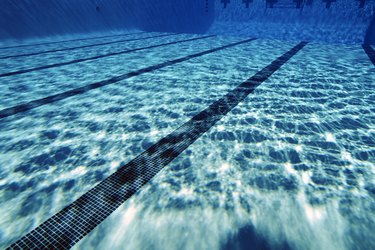
When you install a swimming pool, you may be picturing a backyard oasis for the whole family. What you aren't envisioning is the potential problems that could arise, such as your swimming pool's floor becoming rough. The possible causes of textural changes in your pool floor will vary, depending on the type of pool you have and how it was installed.
Calcium Deposits
Video of the Day
One fact that swimming pool owners everywhere can agree on is that maintaining the proper pH is vital. Without the proper pH, your swimming pool becomes susceptible to algae growth. Keeping a perfect pH at all times isn't always possible, which leaves some pool owners with little choice but to "shock" the pool water with calcium hypochlorite. One unpleasant side effect of calcium hypochlorite is its tendency to leave rough, scaly deposits on the sides and floor of swimming pools. This problem most often occurs in concrete pools. If the floor and sides of your pool become so rough that you can no longer enjoy the pool, draining and re-plastering the pool will remedy the problem.
Video of the Day
Osmotic Blisters
If you have a fiberglass pool with a vinyl liner, the rough spots you feel beneath your feet are likely osmotic blisters. Osmotic blisters occur when water molecules pass through the vinyl liner and come into contact with the polyester resin that lines the pool's mold. Water molecules and polyester molecules combine on contact to form small, hard bumps underneath the pool liner. Fiberglass pool molds often have a layer of vinyl ester resin between the polyester resin and the pool liner. The vinyl ester resin prevents water molecules from coming into contact with the polyester resin and forming osmotic blisters. If the vinyl resin wears away in certain spots or was applied incorrectly, osmotic blisters -- and rough, bumpy patches of liner -- are the result.
Textured Coating
If you recently had your concrete pool re-plastered or had a new resin coat sprayed over your fiberglass pool, the roughness you feel may be textured coating. Rather than being a problem, textured coatings are designed to provide you with additional traction while walking around in the pool. This not only prevents falls while entering the pool, it also prevents swimmers from slipping and unintentionally going underwater while walking around the pool's shallow end.
Sunken Debris
Over time, sediment and debris that blow into your pool water will sink to the bottom. You can clearly see leaves and sticks that fall into the water, but sand that sinks to the bottom of your pool is often invisible to the naked eye. While you cannot always see sand, you'll have no trouble feeling its rough texture on the bottoms of your feet. A simple vacuuming will get rid of sand and other small debris that collect on the bottom of your pool. Par Pool & Spa of Stratford, Connecticut notes that once weekly vacuuming is sufficient for most pools during the season.